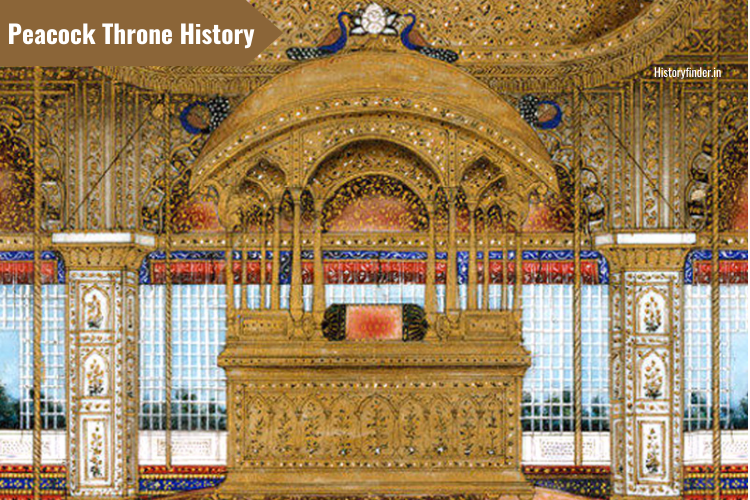The Peacock Throne is the most expensive throne of Indian origin, with an incredible Mughal craftmanship and legacy. Incredible decoration of gemstones and jewels on a pure gold architecture, was indeed a true eye catcher. Shah Jahan, the ‘engineer’ sultan, who wanted every object around him would look like ‘paradise on earth’, was the man to built the throne. However, beside all the noteworthy gems and jewels, the Peacock throne simultaneously consists of some incredible facts. Some of the Peacock throne history are truly interesting.
The marvelous throne is often notable as Mayur Singhasan in Hindi or Takth-e-Tavus in Urdu to the world these days. ‘Peacock’ throne was actually not the name used by Sultan Shah Jahan or his successors. Rather, the throne had a very common name of ‘Takht-e-Murassa’ or ‘Jeweled’ throne during Mughal era. The name ‘Peacock’ throne was actually given by the historians, after the pair of peacocks on its top. Slowly, the original name ‘Takht-e-Murassa’ got faded by the new name ‘Peacock’ throne.
Emperor Shah Jahan spent about 100 million Mughal Rupees to construct the Peacock throne. Although there are many different opinions also exist about the actual making cost Peacock throne. But the Takht-e-Tavas definitely cost more than twice the making cost of Taj Mahal. But, irrespective of the actual cost, such constructions certainly signify the glorifying phase of Shah Jahan era. Some historians also claim that the famous Takht of Shah Jahan belonged to a much higher standard than the Mughals themselves.
History of Peacock Throne
Emperor Shah Jahan commissioned his Takht-e-Murassa or ‘Peacock’ throne on 22nd March in 1635. The very auspicious Eid-al-Fitr and Nowruz, marked Shah Jahan’s accession on the very special throne. Shah Jahan’s Peacock throne was commissioned at the Diwan-e-Khas of Delhi Red Fort, which further glorified the emperor’s seat. Diwan-e-Khas of Delhi thereafter had housed the throne for more than a century. Eventually, the Peacock throne became a symbol of the wealth and power of the Mughal Empire.
The design and artistry of Peacock throne were somehow influenced from the Takht-e-Suleyman (throne of king Solomon). Many historical accounts believe that the throne consisted of 1150 kg of gold and 230 kg of precious stones. However, the historical significance of Peacock throne was far more than its material values.
Persian King Nader Shah invaded Delhi in 1739 and took the original Peacock throne to Iran. But after his assassination in 1747, the Peacock throne became untraceable. Many historical accounts claims that the throne was probably dismantled. Few historians however claim the base of the throne was used in grand Sun throne of Persia. But the claim also lacks solid evidence. So, the Nader Shah invasion brought an end of the incredible history of the gorgeous Peacock throne.
So, Nader Shah remained the last king to ascend the original Peacock throne, where as Muhammad Shah was the last Mughal emperor.

Structural beauty of original Peacock throne
Historical records suggest that the throne had a golden framework, adorned by a multitude of precious gemstones. The fabulous diamonds included 186 carat Koh-e-noor, 95 carat Akbar Shah, 83 carat Jahangir diamond and 88.77 carat Shah diamond. Akbar Shah diamond was called ‘the lustre of Peacock throne’. A huge 352.5 carat Timur ruby was among the other precious gems of the throne including precious emeralds, pearls, and sapphires. Shah Jahan appointed his best craftsmen, who took about seven years to construct the Peacock throne. The value of heavily loaded gemstones, the golden structure, luxurious design and the exquisite craftmanship made the throne priceless.

According to historical accounts, the throne consisted of 1150 kg of gold and 230 kg of gemstones. The mammoth dimension of Peacock throne consisted of 3.5 yeards of length, 2.5 yards of breath and 5 yards of height. Twelve pillars supported the main structure canopy, all made of gold and ornamented with precious jemstones. Inayat Khan, the historian of Mughal period, had mentioned in his ‘Shahjahannama’ about the Sultan’s order to use one crore of Mughal Rupees, 14 lakhs for diamonds and 86 lakhs for other gemstones. The cost cost of gold and other structural part is not however certain.
According to the accounts of French traveller François Bernier, the diamonds were of extraordinary size and value. His words state that the Peacock throne jewels and jems ‘exhibiting a lustre like the sun’. Sir Bernier’s account claims that the Peacock throne had an estimated value of about 4 crores of Mughal Rupees.
Peacock throne replica
A replica of the original Peacock throne was built after Nader Shah returned to Persia. There is no historical record who built the replacement of the throne. However, the Mughal successors enjoyed the pride of Peacock throne for another century. After the Indian rebellion of 1857 and the following British plunder at the Red Fort, the replica Peacock throne disappeared too.




